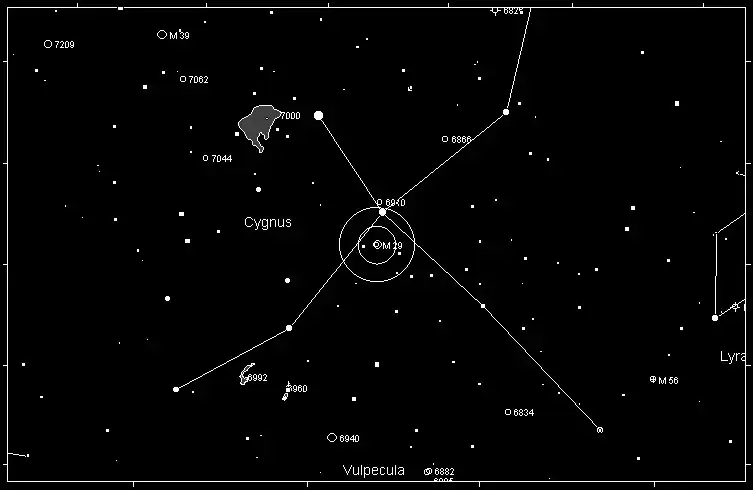Messier 29 (M29), also known as NGC 6913, is a small open star cluster located in the rich star field of the constellation Cygnus, often referred to as the Swan. Open clusters are groups of stars formed from the same molecular cloud, and they typically stay together for millions of years. M29 contains a handful of bright, young blue-white stars that are still relatively close to their birthplace in the galaxy. Despite its small size and relative obscurity compared to other Messier objects, M29 is a fascinating target for amateur astronomers interested in star clusters.
M29 is estimated to be around 10 million years old, making it a young cluster in astronomical terms. The cluster is situated approximately 4,000 light-years away from Earth and is embedded within the dense region of the Milky Way’s galactic plane, which often makes it challenging to observe due to the obscuring interstellar dust. This dust dims the cluster’s brightness, reducing the apparent magnitude that reaches our telescopes.
Magnitude and Visibility
Messier 29 has an apparent magnitude of +7.1, making it a faint object that is not visible to the naked eye but can be observed with binoculars or small telescopes. The cluster spans an angular diameter of about 7 arcminutes, which is equivalent to roughly one-quarter the size of the full moon. Due to its faintness, M29 requires dark skies and good seeing conditions for the best viewing experience.
Prominent Season and Location in the Sky
Messier 29 is best observed in the Northern Hemisphere during the summer months when the constellation Cygnus is prominent in the evening sky. Cygnus is one of the most recognizable constellations due to its distinctive cross shape, which is often referred to as the Northern Cross.
The ideal time to observe M29 is between July and October, when Cygnus is high in the sky, well above the horizon during the night. This elevation helps minimize the effects of atmospheric turbulence, making it easier to spot the cluster.
Constellation: Cygnus
M29 is located in the constellation Cygnus, which represents a swan in classical mythology. The cluster is situated near the bright star Gamma Cygni (Sadr), which marks the heart of the swan. Cygnus is home to many notable deep-sky objects, including the famous Cygnus X-1 black hole and the North America Nebula. Due to the dense star fields of the Milky Way running through this region, Cygnus is a rich hunting ground for star clusters, nebulae, and other celestial wonders.
How to Find Messier 29
Finding M29 requires a telescope, ideally with at least a 4-inch aperture, although it can be glimpsed with good binoculars under dark skies. To locate M29, begin by finding the bright star Gamma Cygni (Sadr), which lies at the center of the Northern Cross asterism in Cygnus.
Once you've found Gamma Cygni, move your telescope just 1.7 degrees south and slightly west. M29 should appear as a small, compact group of stars. Due to the interstellar dust in this region, the cluster may appear somewhat dim and hazy, but careful observation should reveal several bright stars that stand out against the background. The cluster’s stars are often arranged in a pattern resembling a small square or a cross.

History
Messier 29 was discovered by the French astronomer Charles Messier on July 29, 1764. Messier was compiling a list of nebulous objects that could be mistaken for comets in his search for new comets. M29 became the 29th object added to his now-famous catalog, which contains some of the most well-known deep-sky objects visible from Earth.
At the time of its discovery, Messier did not have the tools to resolve the individual stars of the cluster, so he simply noted it as a "nebulous cluster." Later observations revealed the true nature of M29 as an open star cluster. Since its discovery, M29 has been a target for amateur astronomers looking to observe and study stellar clusters within our galaxy.
Conclusion
Messier 29 may not be the most striking or brightest of the Messier objects, but it offers a glimpse into the formation and evolution of star clusters within the Milky Way. Nestled in the rich constellation of Cygnus, M29 provides a rewarding observation experience for those willing to seek out its subtle beauty. Whether you're an amateur astronomer exploring the wonders of the night sky or an astrophotographer capturing the deep-space treasures of the Milky Way, M29 is a worthwhile target during the summer months.
